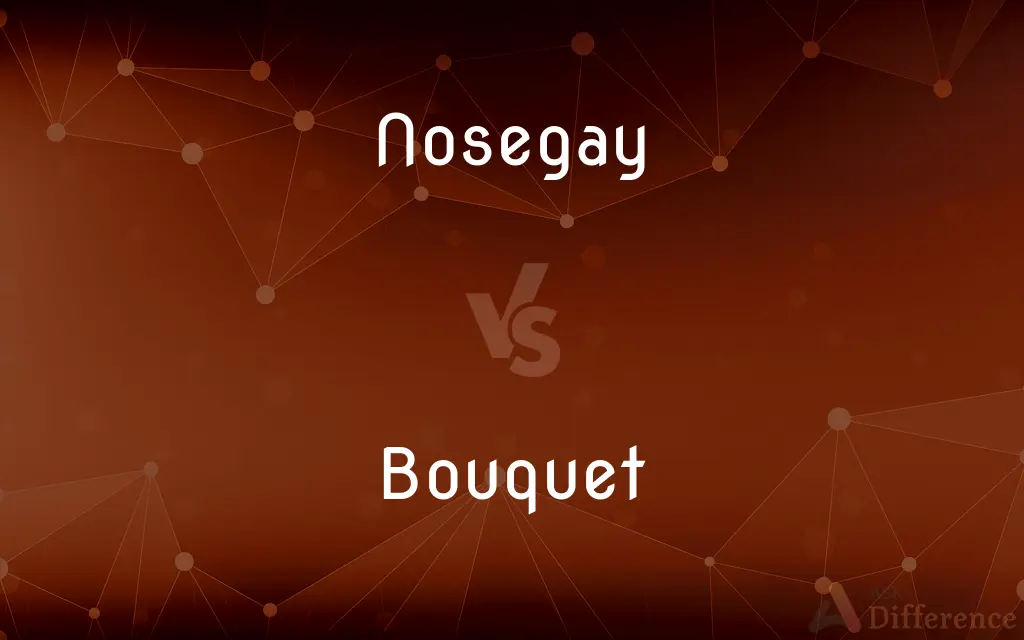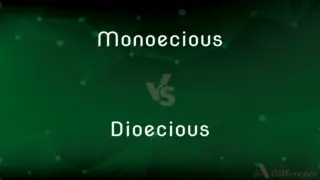Nosegay vs. Bouquet — What's the Difference?
Edited by Tayyaba Rehman — By Fiza Rafique — Updated on April 5, 2024
A nosegay is a small, fragrant bunch of flowers designed to be held in the hand, while a bouquet is generally larger and used for decorative purposes.

Difference Between Nosegay and Bouquet
Table of Contents
ADVERTISEMENT
Key Differences
Nosegays, traditionally small and compact, are designed to be easily held in one hand and often carry a personal or symbolic meaning, making them popular for weddings and as gifts. They typically include fragrant flowers and herbs, which historically were used to mask unpleasant odors, hence the name "nosegay." The arrangement of a nosegay is focused on symmetry and the blending of scents, often tied with a ribbon or lace. Bouquets, on the other hand, vary greatly in size and style, serving as decorative pieces for various occasions, from weddings to home decor. Unlike nosegays, bouquets can be large and unwieldy, designed to be carried with both hands or placed in a vase. The focus of a bouquet is more on the visual impact, incorporating a wider variety of flowers and foliage to create a statement piece. Bouquets may not necessarily include fragrant flowers, as their primary purpose is visual beauty.
While nosegays are intimately sized and often symbolize a specific sentiment or message through the choice of flowers and herbs, bouquets are more about aesthetic appeal and decoration. The choice between a nosegay and a bouquet depends on the occasion, the message one wishes to convey, and the practicality of carrying or displaying the arrangement.
Nosegays and bouquets also differ in their historical significance and usage. Nosegays have a rich history dating back to the medieval times, used not only for their fragrance but also for their supposed health benefits and protection against diseases. Bouquets, however, became popular in more modern times, with their use in weddings becoming widespread in the Victorian era, where the flowers chosen for the bouquet held specific meanings.
The choice between a nosegay and a bouquet hinges on the size, purpose, and occasion for the floral arrangement. Nosegays, with their compact size and fragrant flowers, offer a personal touch and historical charm, while bouquets provide a visually striking option for more formal or decorative needs.
Comparison Chart
Size
Small, easily handheld
Can vary from small to large
ADVERTISEMENT
Purpose
Personal symbolism and fragrance
Decorative, visual appeal
Composition
Fragrant flowers and herbs
Variety of flowers and foliage
Occasion
Weddings, gifts
Weddings, decor, gifts
Historical Use
Masking odors, health benefits
Symbolism in Victorian era, decoration
Compare with Definitions
Nosegay
Designed for fragrance and symbolism.
Each flower in the nosegay was chosen for its meaning.
Bouquet
A decorative arrangement of flowers.
The centerpiece of the table was a large, colorful bouquet.
Nosegay
A compact floral arrangement meant for carrying.
He gifted her a nosegay to symbolize his affection.
Bouquet
Varied in size and design.
She chose a cascading bouquet for her bridal look.
Nosegay
A small cluster of flowers and herbs, tied together.
She carried a nosegay of lavender and roses at her wedding.
Bouquet
Primarily for visual appeal.
The bouquet featured an array of exotic flowers.
Nosegay
Often includes herbs.
The nosegay included mint for freshness.
Bouquet
Can be used for various occasions.
He sent a bouquet of her favorite flowers for her birthday.
Nosegay
Historically used for health and aroma.
In medieval times, a nosegay was believed to ward off illness.
Bouquet
Often placed in a vase.
The bouquet brightened the room from its spot in the vase.
Nosegay
A nosegay, posy, or tussie-mussie is a small flower bouquet, typically given as a gift. They have existed in some form since at least medieval times, when they were carried or worn around the head or bodice.
Bouquet
A small cluster or arrangement of flowers.
Nosegay
A small bunch of flowers; a bouquet.
Bouquet
A fragrant smell, especially of a wine or liqueur.
Nosegay
A small bunch of fragrant flowers or herbs tied in a bundle, often presented as a gift; nosegays were originally intended to be put to the nose for the pleasant sensation or to mask unpleasant odours.
Bouquet
A bunch of cut flowers.
For my birthday I received two bouquets.
Nosegay
(figuratively) An aroma, a scent.
Bouquet
A decoratively arranged bunch of something.
Each table was adorned with a bouquet of giant balloons.
Nosegay
A bunch of odorous and showy flowers; a bouquet; a posy.
Bouquet
The scent of a particular wine.
This Bordeaux has an interesting bouquet.
Nosegay
An arrangement of flowers that is usually given as a present
Bouquet
The heart note of a perfume.
The remarkable flower bouquet lasts for hours until it dissolves into a sweet vanilla smell.
Bouquet
A compliment or expression of praise.
Bouquet
(mathematics) A bouquet of circles.
Bouquet
(card games) The reserve of cards in the game of Flower Garden and variations.
Bouquet
(cartomancy) The ninth Lenormand card, sometimes called Flowers instead.
Bouquet
A nosegay; a bunch of flowers.
Bouquet
A perfume; an aroma; as, the bouquet of wine.
Bouquet
An arrangement of flowers that is usually given as a present
Bouquet
A pleasingly sweet olfactory property
Common Curiosities
When would you use a nosegay?
Nosegays are popular for weddings, proms, or as a personal gift, emphasizing personal meaning and fragrance.
What is a nosegay?
A nosegay is a small, fragrant bunch of flowers and herbs, tied together, traditionally carried in the hand for their scent and symbolism.
When would you use a bouquet?
Bouquets are used for a range of occasions, from wedding decorations to home decor, focusing on aesthetics.
How does a nosegay differ from a bouquet?
A nosegay is smaller and designed for carrying by hand with a focus on fragrance, while a bouquet is larger and designed primarily for visual appeal.
Can a bouquet be used as a wedding centerpiece?
Yes, bouquets can be designed to serve as stunning wedding centerpieces.
Can the size of a bouquet vary?
Yes, bouquets can range from small, delicate arrangements to large, elaborate ones.
Do nosegays and bouquets have to include flowers?
While traditionally made with flowers, both can include other elements like herbs, foliage, and decorative accents.
Are nosegays only for weddings?
No, nosegays can also be used as a thoughtful gift or for special events like proms.
How long have nosegays been around?
Nosegays date back to medieval times, used for their fragrance and supposed health benefits.
What is a bouquet?
A bouquet is a decorative arrangement of flowers, varying in size, and often used for decorative purposes in weddings and as gifts.
Why were nosegays originally used?
Historically, nosegays were used to mask unpleasant odors and were believed to offer protection against diseases.
Can bouquets be used for home decor?
Absolutely, bouquets make beautiful home decor, adding color and life to any space.
Are nosegays and bouquets expensive?
The cost can vary widely based on the type of flowers used, the size of the arrangement, and the complexity of the design.
Is it possible to customize a nosegay?
Yes, nosegays can be personalized with specific flowers and herbs to convey a particular message or sentiment.
What makes a bouquet suitable for weddings?
Bouquets are versatile and can be tailored to match the theme and style of a wedding, making them suitable for bridal parties, decor, and more.
Share Your Discovery

Previous Comparison
Monoecious vs. Dioecious
Next Comparison
Amend vs. MendAuthor Spotlight
Written by
Fiza RafiqueFiza Rafique is a skilled content writer at AskDifference.com, where she meticulously refines and enhances written pieces. Drawing from her vast editorial expertise, Fiza ensures clarity, accuracy, and precision in every article. Passionate about language, she continually seeks to elevate the quality of content for readers worldwide.
Edited by
Tayyaba RehmanTayyaba Rehman is a distinguished writer, currently serving as a primary contributor to askdifference.com. As a researcher in semantics and etymology, Tayyaba's passion for the complexity of languages and their distinctions has found a perfect home on the platform. Tayyaba delves into the intricacies of language, distinguishing between commonly confused words and phrases, thereby providing clarity for readers worldwide.














































